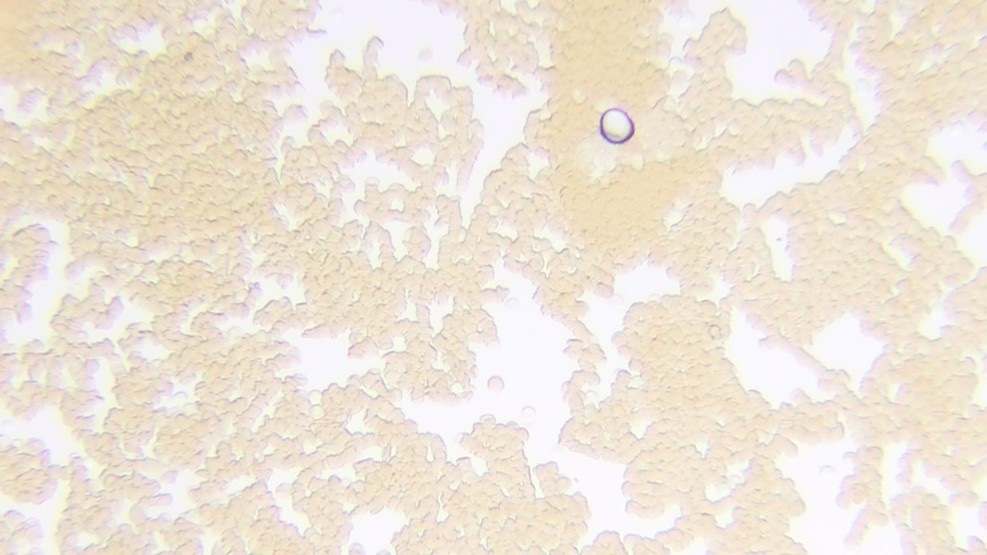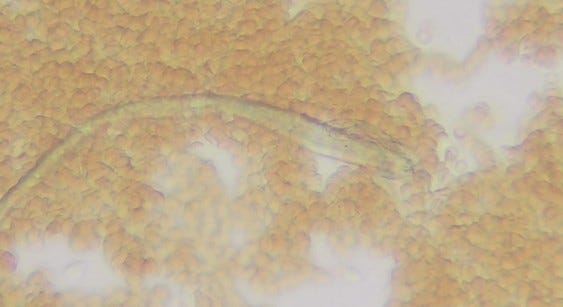One of my missions in life at this point, is finding solutions to nanotech infestation that are free or, at least, very inexpensive. I keep thinking there’s got to be a way to meditate, dance, chant, or listen our way out of this mess. There’s got to be something the big boys at the top haven’t thought of.
They don’t seem terribly ethical or enlightened. Maybe they forgot a little something when it comes to possible antidotes. Sweat lodges? Chakra clearing? Rosary beads, maybe? I’m beyond tired of reading about, and testing, various supplements, only to find that most of them, either contain nanotechnology, or have significant downsides. What excites me more are things we might be able to do for ourselves, or rig together somehow.
I’d thought about sound frequencies, and how they might interact with nanotechnology for a long time, but couldn’t think of a good way to test this. Then, a few months ago, I found out there was a lady in my area using a sound therapy technique called: Biotuning.
That gave me an idea, I’d get some Biotuning done on myself and test my blood before and after treatment to see what, if anything, changed. When I called the sound practitioner, she was open to the idea of doing an experiment, so we set a date.
She explained that she used headphones to deliver sound frequencies, and had a chair for her clients to sit in, that transmitted complementary physical vibrations. She told me she liked to use sound frequencies in the Delta range (0.5-4 Hz) for approximately 10 minutes, and then introduce frequencies in the Theta range (4 to 8 Hz.), and said treatment would last thirty minutes. I thought that might not be long enough to produce noticeable changes in my blood, so I negotiated for an hour. As it happened, I only lasted twenty-two minutes. Things got more exciting than I bargained for.
When the day arrived, I fasted for four hours, so there wouldn’t be too many digestion-related particles in my blood. When the four hours were up, I poked my finger to get a sample of capillary blood, put it on a slide with a coverslip, and spent an hour taking pictures of what appeared under the microscope. Once that was done, I proceeded to the site of the sound experiment, about 20 minutes away.
So as not to disappoint you, I’ll let you know at the outset that not all of the changes were good. Some of the changes were very good and, in my humble opinion, some were very bad.
Here’s what happened:
I sat in the vibrating chair; put headphones on; and tried to relax. My partner in crime left shortly, thereafter, to go for a walk. In retrospect, it would have been MUCH better if she’d stayed.
Everything was fine at first. That is, for the first 10 minutes: before the Theta range frequencies started. That’s when terror struck. Yup. Terror!
Heart Arrythmia runs in my family and it’s a significant problem for me. My heart has a tendency to jump around a lot in terms of speed, but I usually feel like I have at least some control I can exercise via thought, when it comes to matters of life and death. During the experiment I lost that feeling of safety.
When my chest tightened up the first time, I thought the sensation might be psychological. The feeling got better and worse, intermittently, so I reasoned that it could be stress. I thought if I could just relax and calm down, everything would be fine. (At least that’s what I told myself.) As the treatment continued, my overall condition worsened, and panic began to set in.
“Should I turn off the machine, or just stand up?” I asked myself. “No, calm down!” said another part of me. “You always do this! This isn’t EMF. You’re just being too sensitive again. You’re probably just imagining things. It’s all in your head. You came all this way, fasted for several hours, and took before pictures of your blood. Just stay and finish the darn project! Come on!”
The voice of internal damnation kept me in my seat for 12 more minutes. When, legitimate, no nonsense chest pain arrived, my body had enough of my mind’s nonsense and took over. Without taking many more seconds to think, I got up abruptly, took off the headphones, and began looking around for help. “Thank you body! I know I’m a bit dense sometimes.”
The sound practitioner came back a couple of minutes later, looking perplexed. When I explained what happened, she said the process wasn’t recommended for people with pacemakers. “Well…” I said, “I probably should have a pacemaker, I just don’t!”
I felt awful, exhausted and a bit scared. I couldn’t escape the feeling of having been halfway baked. What was my blood going to look like now? Something certainly must have happened to it!
When I got home after twenty more minutes and looked at my blood, my mouth dropped open. Remember how I said, some very good things AND some very bad things happened? My blood showed it.
The scene on the slide before me was utterly confusing. Did the two different frequencies do different things? Was one good and one bad? Were my fear, angst and irregular heart rhythms to blame for the results that were negative? Would the results have been vastly different if the test had been done on someone else? The answers to these questions are still unknown. Let’s take a look at the evidence we do have, and see if we can work out what happened.
Picture #1 - My Blood BEFORE the Sound Treatment - Sample #1
In the picture above, you can see that most of my red blood cells are stuck together; as opposed to being separated like they should be. Some are stacked together in rolls (Rouleau), and some are clustered together in clumps (Erythrocyte Aggregation). There are several health issues that can cause this, but the presence of nanotechnology could, potentially, worsen the problem.
When red blood cells lose the negative charge they need to repel each other, they have a tendency to form rolls or clumps. Because many programmed nanoparticles carry a positive charge, our body’s delicate electrical balance can get disrupted, when we unwittingly consume them. When red blood cells are stuck together, they can’t deliver oxygen and nutrients to body tissues as quickly and efficiently as they need to. Over time, this can lead to a host of health problems.
Picture #2 - My Blood AFTER the Sound Treatment - Sample #2.
See all of the nicely-spaced red blood cells? Somehow, someway, the sound treatment seemed to have fixed my blood’s electrical problems. I was impressed!
I was confused, though, because I felt badly. I had almost no energy, and was struggling get through the process of looking at the second sample and taking pictures. All I wanted to do was fall into bed and wake up 10 hours later.
Luckily, my inner critic was NOT similarly exhausted. “Come on! You’re almost done! Just stay with it! Don’t waste the whole experience. This information could be valuable someday!”
When I looked at the picture more intently, I realized something was wrong. The blood in the second sample looked too light. I picked up the slide with the first sample on it, so I could compare it to the one I was looking at now. The blood on the first slide was still quite red, in spite of being two hours old. Go back up to Picture #1. Do you notice the difference in color?
Paler red blood cells have less Hemoglobin in them than redder ones do. Hemoglobin helps red blood cells carry oxygen around the body. To produce it, the body needs Iron. My much greyer blood, post sound treatment, lacked iron.
That’s when my confusion shifted to concern. To this day, I don’t know where I first heard it, but by then, I’d heard the same thing from a number of sources: “Nanotechnology can lead to Iron depletion and Anemia.” Because I couldn’t seem to find any of the sources I’d heard this from, I had a little fight with AI Overview in Google.
I started typing iron/nanotechnology-related questions into the Google search bar, and got an assortment of answers. One answer assured me that nanotechnology does NOT use the body’s iron for energy. Another claimed that nanotechnology is being used to improve iron supplements. I finally cornered it when I asked: “Can nanotechnology lead to Anemia?” Ah Ha! I got it with that one! That’s when it told me nanoparticles can interfere with iron absorption, and cause oxidative stress that can, in turn, lead to Anemia.
Right! I thought so! I now had some weak proof of what I’d heard in the past. Although… what I’d actually heard, was that nanotechnology steals iron from your body. Oh well, at least I now had some weak proof of a possible link between nanotechnology and Anemia. (Assuming AI wasn’t hallucinating again - or just trying to get rid of me.)
Was I going to find more evidence of nanotechnology in my blood as it aged? Or, did stress of the experience, itself, lead to Iron depletion? According to AI Overview, that’s was distinct possibility too, as stress on it’s own can cause iron loss.
Let’s take a look at more of the positive things that happened before continuing with possible downsides.
When I took the first sample of my blood, it had about seven oblong objects in it that looked similar to the one seen below in Picture #3. If we were to ask the Bigelsen Brothers, they might say these objects were ‘scars,’ (See my April 28, 2025 Substack article, entitled: “Holographic or Nanotech-Affected Blood: The Conflict that Shouldn’t Exist” ). For more information on ‘scars,’ see minute 102:00 to 102:50 in “#68: The Holographic Blood with Adam Bigelsen" posted on Rumble by A Light On, (approximately 5 months prior to publication of this article).
Nanotech researchers, on the other hand, might see such structures as evidence of Hydrogel. Whatever they were, there were a lot of them. Here’s an example of one:
Picture #3 - My Blood BEFORE the Sound Treatment - Mystery Object. Hydrogel Strand, ‘Scar,’ or Something Else?
There were only two objects like these in the sample I took after the sound treatment and they were quite a bit smaller than the one seen above. It’s very possible that the sound treatment led to an overall reduction.
There were also some other pesky things in my blood before the sound treatment that were missing afterwards.
Picture #4 - Dry Portion of My Blood BEFORE The Sound Treatment (Aged About 1 Hour)
One strand and seven crystal-like objects can be seen above. What the crystal-like objects are has become a subject of debate. According to my training in Live Blood Analysis, the shapes seen above are Protoplasts: collections of waste, fat and protein that that body hasn’t been able to eliminate. Recently, however, microscopy researchers, like Dr. Ana Mihalcea, have linked some objects like this to forms of nanotechnology. (See Dr. Ana Mihalcea’s April 27, 2024 Substack article, entitled: “Darkfield Live Blood Microscopy Of A Discoid Mesogen Self Assembly Nanotechnology Device In C19 Unvaccinated Blood”
Whatever they were before the sound experiment, they weren’t good. After the sound experiment, NONE were present. It’s likely that the sound treatment contributed to their annihilation. YAY!
I wish that was all I had to report, but it’s not. Something else happened that still has me baffled. Blood structures in sample #1 were still alive and moving two hours after I took the sample, and continued to exhibit signs of life for two more hours. The blood on slide #1 maintained it’s deep red color into the following day. In contrast, most areas of the blood on slide #2 were dry within an hour. By the following day, I had to hold the slide up to the light and strain, to see any blood under the coverslip on that slide. It was disappearing.
There’s some disagreement in the research community about whether long lasting blood is a good thing or bad thing. When I studied Live Blood Analysis, I learned that fast drying blood is a sign of poor health. However, some researchers have pointed out that blood often stays active a lot longer on slides than it used to, and worry that nanotechnology might be to blame. All I can say for sure, is that the feeling of seeing my blood die quickly and disappear wasn’t a good one.
Something else bothered me too. After forty minutes on the slide, the boundaries of my red blood cells were still intact, but many of them were empty inside.
Picture #5 - My Blood AFTER Sound Treatment (Aged 40 Minutes) - Mostly Empty Red Blood Cells.
Here’s what normal, unhealthy blood, from a person who could use a better diet, looks like after 2-4 hours:
Video #1 - Aged, Unvaccinated Blood with Signs of Ill-health.
I never thought I’d prefer to have the blood Video #1 over my blood as it appears in Picture #5, but seeing virtually nothing in my blood after 40 minutes: no ocean floor scenes, no sea creatures, nothing… made me want to cry. There’s a possibility the red blood cells in Picture #5 were on their way to becoming synthetic, but that’s for another article.
After looking at the results, I did a little digging and learned that nanotechnology developers have been known to use sound in the development of nanotechnology. Using the wrong kind of sound, or using it in the wrong way, could not only fail to help, it could make things worse.
Proceeding cautiously is a must, when exploring the detoxification properties of sound. Finding the right frequencies, and the most effective way to deliver them, is likely to be more complicated than I had hoped. Like supplements and frequencies of light, sound can be either healing or toxic. And, the state your body is in might matter a lot.
We shouldn’t let a little complexity stop us, though. After all, sound frequencies used in a single experiment free my red blood cells; got rid of crystals or ‘scars’, (as the case may be); and reduced the population of oblong, snot-colored objects that nobody in their right mind wants in their blood. Bravo for sound, I say!
Thanks for reading!
Daisy









Hi Daisy,
Yup, the best microscopists are guinea pig scopists for the greater good. Thanks for joining the club.
With todays optogenetics, wavelengths and frequencies are critical to get right.
Good work, Thanks. m
I had Rouleau as well, with the symptoms of being very exhausted, rest not fixing such... Found after I bought my first microscope, used CDS to clear it up and get my blood oxygenated... Also I sleep Grounded with an extra negative potential to push electrons... The structure that is long in the pics could well be parasites as I have observed similar things in samples... I later popped a cyst and the contents were put on a slide and viewed under the microscope and found lots of very tiny worms, about 1 to 3 blood cells wide and 20-40 long... Treated myself for micro worms with typical anti parasitic meds... Because it takes a long time to properly kill off parasites (see Dr. Lee Merritt vids) and infected red blood cells are replaced over a long time like 3 months, I then took another sample months later and placed under the microscope and all was clear of structures and no longer had RBC with bumps on them... To expose LNP one may need to take Monolaurin in essence a compound that acts like a soap to break open LNP so the immune system can attack the contents before the contents are delivered through a cell wall... There many detox methods and by using all of the ones I can find, my blood cleaned up nicely... The rest of the story is long...